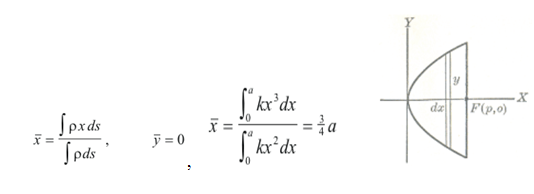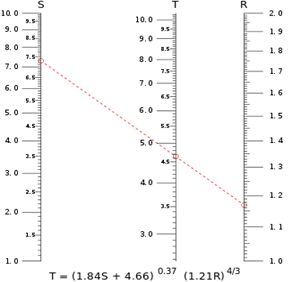1. For locating the position of the centre of gravity of an area of unsymmetrical shape, it is first divided into a number of ______________ of symmetrical shapes.
a) smaller areas
b) larger areas
c) identical areas
d) same areas
Explanation: For locating the position of the centre of gravity of an area of unsymmetrical shape, it is first divided into a number of Smaller areas of symmetrical shapes such as triangle, squares, rectangles, trapezoids etc. so that the centre of gravity of each such area is easily determined. Each small area is then treated as a force proportional to the area and acting at the centre of gravity of the area.
2. The sum of the products of the area of its elements and the squares of the perpendicular distances of the centres of gravity of these elements from the axis is called ___________
a) centrifugal force
b) moment of inertia of areas
c) centripetal force
d) centre of gravity
Explanation: It is a measure of an object’s resistance to changes to its rotation.
•Also defined as the capacity of a cross-section to resist bending.
•It must be specified with respect to a chosen axis of rotation.
•It is usually quantified in m4 or kgm2.
3. The moment of inertia is graphically determined by ___________ with the help of space diagrams, polar diagram, force diagram and funicular polygons.
a) culmann’s method
b) calibration method
c) continuity method
d) coloumb method
Explanation: Based on the sliding plane hypothesis of Coulumb earth pressure theory, a new method for calculation of the passive earth pressure of cohesive soil was constructed with Culmann’s graphical construction. The influences of the cohesive force, adhesive force, and the fill surface form were considered in this method.
4. The unit of moment of inertia will be in ______
a) Length*distance2
b) Area2*length
c) Area*distance3
d) kilogram metre squared
Explanation: The amount of torque needed to cause any given angular acceleration (the rate of change in angular velocity) is proportional to the moment of inertia of the body. Moment of inertia may be expressed in units of kilogram metre squared (kg. m2) in SI units and pound-square feet (lb. ft2) in imperial or US units
5. In case of an area, the figure is assumed to be a lamina of negligible thickness so that its centre of gravity will be practically on the surface. As the area has no weight this point is also called the ______
a) Moment of inertia of areas
b) Centre of gravity
c) Centroid
d) Neutral axis
Explanation: In mathematics and physic, the centroid or geometric center of a plane figure is the arithmetic mean (“average”) position of all the points in the shape. The definition extends to any object in n-dimensional space: its centroid is the mean position of all the points in all of the coordinate directions. Informally, it is the point at which a cut out of the shape could be perfectly balanced on the tip of a pin.
6. The density of a certain rod a foot long varies directly as the square of the distance from one end. Find the centre of gravity.
a) 4/3a
b) 3/4a
c) 1/3a
d) 1/4a
Explanation: Place the rod on the x-axis, one end at the origin so that ρ = kx2,

where a is the length of the rod.
7. ___________ are combination of more than two straight or curved scales aligned in a definite way so that when a straight line drawn across the scales intersects them at values satisfying the represented equation.
a) Hydrograph
b) Namographs
c) Nomographs
d) Hygrograph
Explanation: A nomogram also called a nomograph, alignment chart or abaque, is a graphical calculating device, a two-dimensional diagram designed to allow the approximate graphical computation of a mathematical function. An arrangement of two linear or logarithmic scales such that an intersecting straight line enables an intermediate values or values on a third scale to be read off.
8. Which is not the type of nomograph?
a) Z- type nomograph
b) Circular nomograph
c) Y- type nomograph
d) Combination of nomograph
Explanation: Y- type nomograph does not exist. The other fourth type of nomographs includes Parallel scales nomograph.
9. Which short of instrument is shown below?

a) 3 Geometrical scale
b) Parallel-scale nomogram
c) Thermometer
d) Barometer
Explanation: The field of nomography was invented in 1884 by the French engineer Philbert Maurice d’Ocagne (1862-1938) and used extensively for many years to provide engineers with fast graphical calculations of complicated formulas to a practical precision. Nomograms use a parallel coordinate system invented by d’Ocagne rather than standard Cartesian coordinates.
A nomogram consists of a set of n scales, one for each variable in an equation. Knowing the values of n-1 variables, the value of the unknown variable can be found, or by fixing the values of some variables, the relationship between the unfixed ones can be studied. The result is obtained by laying a straightedge across the known values on the scales and reading the unknown value from where it crosses the scale for that variable. The virtual or drawn line created by the straightedge is called an index line or isopleth.
10. Which is not the application of nomography?
a) Ballistics calculations prior to fire control systems, where calculating time was critical
b) Operations Research, to obtain results in a variety of optimization problems
c) The design of channels, pipes and weirs for regulating the flow of water
d) In measuring water velocity
Explanation: The current velocity meter allows you to measure stream flow velocity in feet or meters per second and measure water depth in hundredths of a foot up to three feet. The average stream flow velocity times the cross-sectional area of the stream determines the stream flow measurement in cubic feet or meters per second.